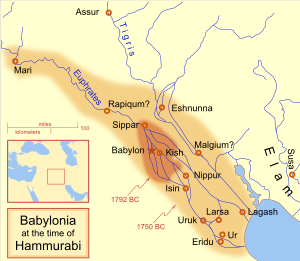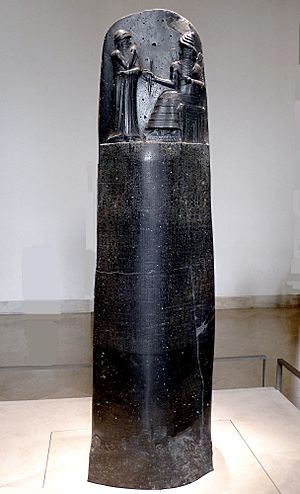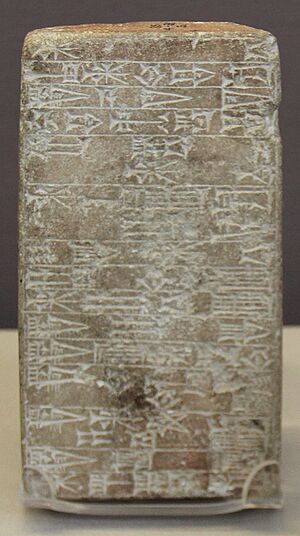Hammurabi facts for kids
Quick facts for kids Hammurabi𒄩𒄠𒈬𒊏𒁉 |
|
|---|---|
| King of Babylon King of the Four Corners of the World |
|
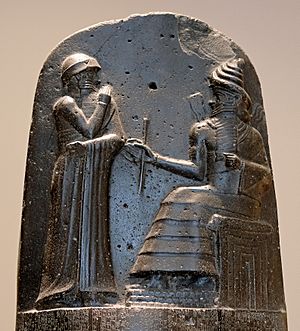
|
|
| King of the Old Babylonian Empire | |
| Reign | c. 1792 – c. 1750 BC (MC) |
| Predecessor | Sin-Muballit |
| Successor | Samsu-iluna |
| Born | c. 1810 BC Babylon |
| Died | c. 1750 BC (aged 59–60) Babylon |
| Issue | Samsu-iluna |
Hammurabi (pronounced Ham-oo-RAH-bee), also spelled Hammurapi, was a powerful king of ancient Babylon. He ruled the Old Babylonian Empire from about 1792 BC to 1750 BC. Hammurabi was the sixth king from a group of people called the Amorites. He took over from his father, Sin-Muballit, who stepped down due to poor health.
During his long reign, Hammurabi greatly expanded his kingdom. He conquered many important city-states like Larsa, Eshnunna, and Mari. He also defeated Ishme-Dagan I, the king of Assyria. Hammurabi made almost all of Mesopotamia part of the Babylonian Empire.
Hammurabi is most famous for creating his special set of laws, known as the Code of Hammurabi. He said that Shamash, the Babylonian god of justice, gave him these laws. Unlike some older law codes, Hammurabi's laws focused on clear rules and consequences for actions. It was one of the first law codes to suggest that someone accused of a crime should have a chance to prove their innocence.
Many people saw Hammurabi as a god during his lifetime. After his death, he was remembered as a great leader who brought order and justice. His laws were copied and studied for hundreds of years. Today, Hammurabi is still seen as a very important figure in the history of law.
Contents
Hammurabi: Ancient Babylon's Great King
Hammurabi's Rise to Power in Babylon
Hammurabi became king of Babylon around 1792 BC. At that time, Babylon was a small kingdom. It was surrounded by many other powerful city-states in Mesopotamia. These kingdoms often fought over fertile farmland.
Babylon was founded in 1894 BC. For about a century, it was not as strong as older kingdoms. These included Elam, Assyria, Isin, Eshnunna, and Larsa. However, Hammurabi's father, Sin-Muballit, started to unite a small area around Babylon. By the time Hammurabi became king, Babylon controlled nearby cities like Borsippa, Kish, and Sippar.
The kingdom of Eshnunna controlled the northern Tigris River. Larsa controlled the river delta in the south. To the east was the strong kingdom of Elam. Elam often attacked and demanded payments from smaller states. In the north, the Assyrian king Shamshi-Adad I had built a large empire. But his death caused his empire to break apart. This complex situation set the stage for Hammurabi's reign.
Expanding the Babylonian Empire
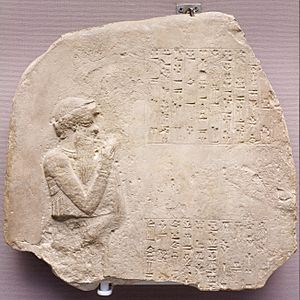
The first few years of Hammurabi's rule were peaceful. He used this time to improve his kingdom. He made the city walls taller for better defense. He also expanded and improved the temples.
Then, the powerful kingdom of Elam invaded Mesopotamia. Elam attacked and destroyed Eshnunna. It took control of parts of the plain. Elam then tried to cause a war between Babylon and Larsa. But Hammurabi and the king of Larsa discovered this plan. They formed an alliance and defeated the Elamites.
Hammurabi was not happy that Larsa did not help much in the fight. So, he turned his army against Larsa. By about 1763 BC, he controlled all of the southern Mesopotamian plain.
Hammurabi's allies from the north, like Yamhad and Mari, had helped him in the south. When their soldiers were away, there was unrest in the north. Hammurabi then focused on the north. He quickly put down the unrest and destroyed Eshnunna. Next, his armies conquered other northern states, including Mari. It is thought that Mari might have surrendered without a fight.
Hammurabi then fought a long war with Ishme-Dagan I of Assyria. Both kings made alliances with smaller states. Hammurabi eventually won, defeating Ishme-Dagan I. Mut-Ashkur, the new king of Assyria, had to pay tribute to Hammurabi.
In just a few years, Hammurabi united almost all of Mesopotamia. Only Aleppo and Qatna in the west remained independent. A stone monument of Hammurabi was found far north in Diyarbekir. On it, he called himself "King of the Amorites."
Many ancient clay tablets from Hammurabi's time have been found. These include 55 of his own letters. They show what it was like to rule an empire. He dealt with floods, changed the calendar, and managed large herds of animals. Hammurabi died around 1750 BC. His son, Samsu-iluna, became king. However, the Babylonian Empire soon began to shrink under his rule.
The Famous Code of Hammurabi
What Was Hammurabi's Code?
The Code of Hammurabi was a collection of 282 laws. It covered many different topics. While it wasn't the very first set of laws, it became very important. Unlike older Sumerian laws that focused on helping the victim, Hammurabi's Code focused on clear consequences for the person who broke the law.
It was also one of the first law codes to set limits on what a wronged person could do for revenge. The code also included an early idea of presumption of innocence. This meant that both the accused and the accuser had a chance to show evidence. Each offense had a specific consequence. The laws were designed to create a fair and orderly society.
Where to See the Code Today
The Code of Hammurabi was carved onto a large stone monument called a stele. This stele was placed in a public area. This way, everyone could see the laws, even though few people could read. Later, the Elamites took the stele to their capital, Susa.
Archaeologists rediscovered the stele in 1901 in Iran. Today, you can see it in the Louvre Museum in Paris. The laws were written by scribes on 12 tablets. They were written in Akkadian, which was the everyday language of Babylon. This meant that any person who could read in the city could understand them. Hammurabi's language changes helped make Akkadian the most common language of his time. A carving at the top of the stele shows Hammurabi receiving the laws from Shamash, the Babylonian god of justice. The introduction to the code says that Shamash chose Hammurabi to bring these laws to the people.
Because of his reputation as a lawmaker, images of Hammurabi can be found in law buildings around the world. He is one of 23 lawgivers shown in marble carvings in the chamber of the United States House of Representatives. A frieze (a decorative band) showing "great lawgivers of history," including Hammurabi, is on the south wall of the U.S. Supreme Court building.
Hammurabi's Lasting Legacy
How Hammurabi Was Remembered
Hammurabi was highly respected by later kings. He even received the special honor of being called a god during his lifetime. People often named their children "Hammurabi-ili," meaning "Hammurabi is my god."
After his death, people remembered Hammurabi for three main things: winning wars, bringing peace, and establishing justice. His conquests were seen as a sacred mission to spread civilization. A monument from Ur praises him as a mighty ruler who defeated evil and made all people worship Marduk, the main god of Babylon.
Over time, Hammurabi's role as a great lawmaker became the most important part of his legacy. His military victories were still remembered, but his laws were seen as his greatest achievement. For centuries after his death, scribes copied Hammurabi's laws as part of their writing practice. They were even partly translated into Sumerian.
Hammurabi's Influence on Later Laws
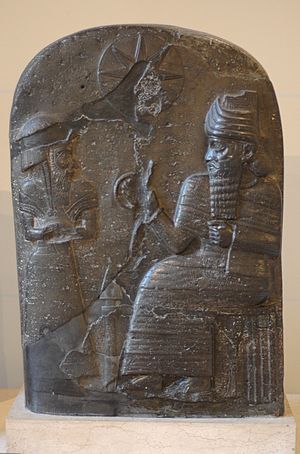
During Hammurabi's reign, Babylon became the most important religious city in southern Mesopotamia. However, after his death, the Babylonian Empire began to weaken under his son, Samsu-iluna. Other groups, like the Assyrians and the Sealand Dynasty, took back territory. Babylon soon became a small state again.
Hammurabi's Amorite Dynasty ended around 1595 BC. The powerful Hittite Empire attacked and conquered Babylon. The Hittites did not stay, but they handed Babylon over to their allies, the Kassites. The Kassite Dynasty ruled Babylon for over 400 years. They adopted many parts of Babylonian culture, including Hammurabi's code of laws.
Even after his dynasty fell, Hammurabi was still remembered. When the Elamite king Shutruk-Nahhunte I raided Babylon in 1158 BC, he took many stone monuments. He usually erased the old writings and carved new ones. But on Hammurabi's law stele, only a few columns were erased, and no new writing was ever added. This shows how much respect people had for Hammurabi's laws. Even over a thousand years after his death, kings in other lands claimed Hammurabi as their ancestor.
Scholars have found many similarities between Hammurabi's laws and later legal texts. These include laws found in the Bible, such as the Law of Moses. While it's unlikely that one directly copied the other, these similarities suggest they came from a common legal tradition in the ancient Middle East. In 2010, archaeologists found a clay tablet at Hazor in Israel. This tablet, from the 18th or 17th century BC, contained laws clearly based on Hammurabi's Code. This discovery shows how widely Hammurabi's legal ideas spread.
See also
 In Spanish: Hammurabi para niños
In Spanish: Hammurabi para niños


